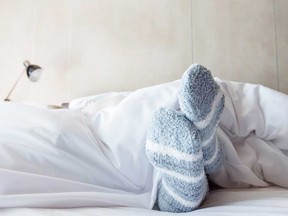Health
Warm Feet: A Simple Trick to Improve Sleep Quality

Struggling to get a good night’s sleep? A growing body of research suggests that warming your feet before bedtime can significantly enhance your ability to fall asleep quickly. This simple technique, endorsed by scientific studies, may rival the effectiveness of many over-the-counter sleep aids.
According to William Wisden, a professor at Imperial College London, warming the extremities, particularly the feet, prepares the body for sleep. Methods such as taking a warm bath, soaking your feet in warm water, or wearing socks to bed can create a cozy environment conducive to sleep. Wisden describes this practice as a “natural sleep medication,” as it helps induce drowsiness and facilitates the transition to sleep.
Research supports this claim, with a notable 1999 study in the journal *Nature* indicating that the dilation of blood vessels in the feet is a strong predictor of how quickly individuals fall asleep. This effect was found to be more significant than melatonin levels or subjective feelings of sleepiness. Additionally, a randomized controlled trial involving 46 men over the age of 60 showed that warming the feet in a bath one hour before bedtime improved both the speed of falling asleep and overall sleep duration.
Scientific Insights into Sleep and Body Temperature
A 2019 meta-analysis further corroborated these findings, revealing that even a brief warm bath or shower—lasting as little as ten minutes—helps individuals fall asleep approximately nine minutes faster and enhances sleep efficiency. In comparison, melatonin supplements typically result in a seven-minute quicker onset of sleep, while the prescription drug zolpidem, known as Ambien, generally assists in falling asleep ten to twenty minutes faster.
Wisden emphasizes that the timing of warming your extremities is crucial. This practice should be implemented closer to bedtime, as taking warm baths too early in the day does not yield the same benefits. Scientists believe that warming your feet helps regulate core body temperature; as blood vessels dilate, it allows the body’s core to cool, which is necessary for deep sleep. The ideal sleeping environment combines warm skin and cooler ambient temperatures, providing the conditions needed for restorative rest.
It’s noteworthy that while many individuals prefer sleeping with warm feet, they often wake up in the night feeling overheated. This discomfort can disrupt sleep quality, emphasizing the importance of an adaptable sleep environment. Wisden advises using layers, such as blankets and socks, to adjust your microenvironment throughout the night, ensuring comfort as body temperatures fluctuate.
Finding Your Optimal Sleep Temperature
Determining the right room temperature for sleep often sparks debate among individuals. The National Sleep Foundation recommends a temperature range of 60 to 67 degrees Fahrenheit (approximately 15 to 19 degrees Celsius) for optimal sleep comfort. However, personal preferences vary widely, with some individuals favoring cooler conditions while others prefer a warmer setting.
It’s also essential to be mindful of medications that may counteract the benefits of warming your feet before bed. Nonsteroidal anti-inflammatory drugs (NSAIDs), such as ibuprofen or aspirin, can constrict blood vessels, potentially negating the positive effects of warm baths or socks. Research indicates that NSAIDs may disrupt sleep cycles, while alternatives like acetaminophen do not carry the same risks. Consulting a healthcare professional for pain management options may be beneficial for those seeking to improve their sleep quality.
As more people seek effective ways to enhance their sleep, warming the feet emerges as a simple yet powerful method. With minimal effort and proven results, this technique could be the key to achieving a more restful night’s sleep.
-

 Education2 months ago
Education2 months agoBrandon University’s Failed $5 Million Project Sparks Oversight Review
-

 Lifestyle3 months ago
Lifestyle3 months agoWinnipeg Celebrates Culinary Creativity During Le Burger Week 2025
-

 Science3 months ago
Science3 months agoMicrosoft Confirms U.S. Law Overrules Canadian Data Sovereignty
-

 Health3 months ago
Health3 months agoMontreal’s Groupe Marcelle Leads Canadian Cosmetic Industry Growth
-

 Science3 months ago
Science3 months agoTech Innovator Amandipp Singh Transforms Hiring for Disabled
-

 Technology3 months ago
Technology3 months agoDragon Ball: Sparking! Zero Launching on Switch and Switch 2 This November
-

 Education3 months ago
Education3 months agoRed River College Launches New Programs to Address Industry Needs
-

 Technology3 months ago
Technology3 months agoGoogle Pixel 10 Pro Fold Specs Unveiled Ahead of Launch
-

 Technology1 month ago
Technology1 month agoDiscord Faces Serious Security Breach Affecting Millions
-

 Business2 months ago
Business2 months agoRocket Lab Reports Strong Q2 2025 Revenue Growth and Future Plans
-

 Science3 months ago
Science3 months agoChina’s Wukong Spacesuit Sets New Standard for AI in Space
-

 Education3 months ago
Education3 months agoAlberta Teachers’ Strike: Potential Impacts on Students and Families
-

 Technology3 months ago
Technology3 months agoWorld of Warcraft Players Buzz Over 19-Quest Bee Challenge
-

 Business3 months ago
Business3 months agoNew Estimates Reveal ChatGPT-5 Energy Use Could Soar
-

 Business3 months ago
Business3 months agoDawson City Residents Rally Around Buy Canadian Movement
-

 Education3 months ago
Education3 months agoNew SĆIȺNEW̱ SṮEȽIṮḴEȽ Elementary Opens in Langford for 2025/2026 Year
-

 Technology1 month ago
Technology1 month agoHuawei MatePad 12X Redefines Tablet Experience for Professionals
-

 Technology3 months ago
Technology3 months agoFuture Entertainment Launches DDoD with Gameplay Trailer Showcase
-

 Business3 months ago
Business3 months agoBNA Brewing to Open New Bowling Alley in Downtown Penticton
-

 Technology3 months ago
Technology3 months agoGlobal Launch of Ragnarok M: Classic Set for September 3, 2025
-

 Technology3 months ago
Technology3 months agoInnovative 140W GaN Travel Adapter Combines Power and Convenience
-

 Science3 months ago
Science3 months agoXi Labs Innovates with New AI Operating System Set for 2025 Launch
-

 Technology3 months ago
Technology3 months agoNew IDR01 Smart Ring Offers Advanced Sports Tracking for $169
-

 Technology3 months ago
Technology3 months agoDiscover the Relaxing Charm of Tiny Bookshop: A Cozy Gaming Escape










